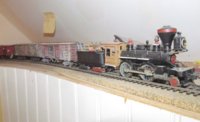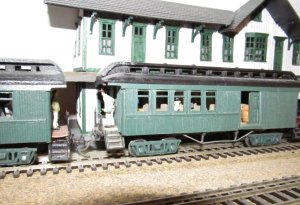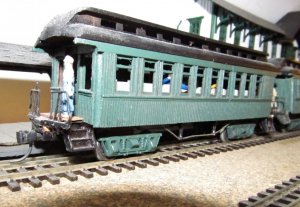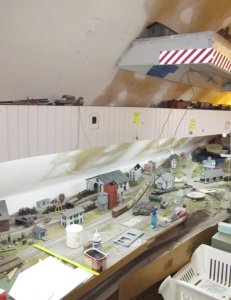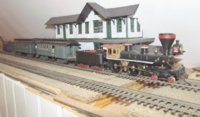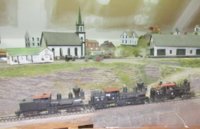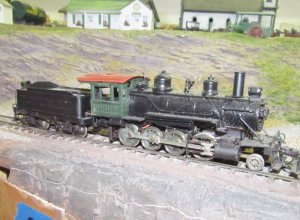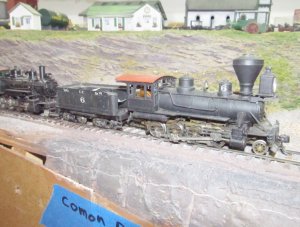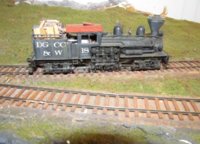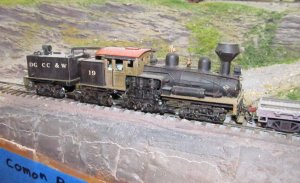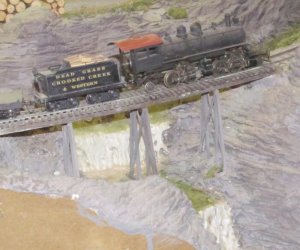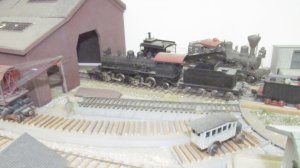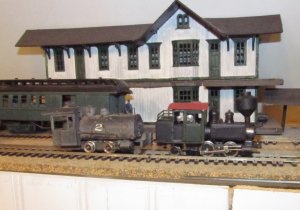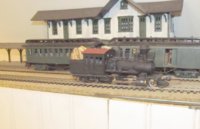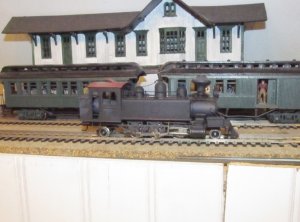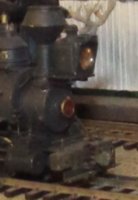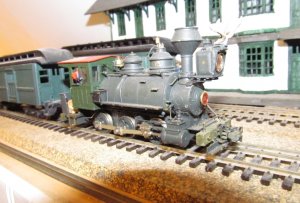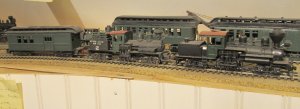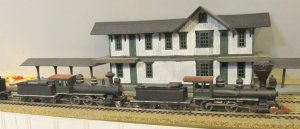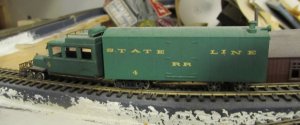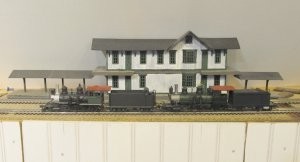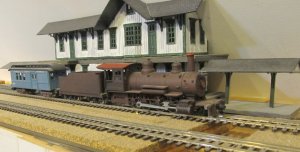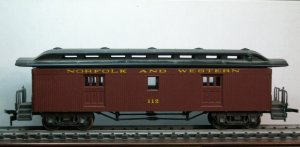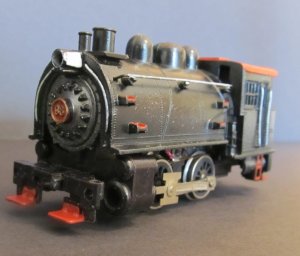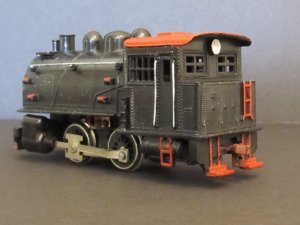Thank you, Zathros, not only do the work, but most work well to exceptionally well, if not they go to the shops, and some never return from the shops, except in pits an pieces, the most notable being the JW Bowker stacks and headlights, winch I may have to try to reproduce in resin.
In the last post we saw #6, #7, #8,#9, and #10. Our first photo in this installment is #14, a relatively new addition, #14 has only been on my roster for about ten years. It is a PFM, United class b Climax, when I bought it , it had the looks of a locomotive that had never seen service, I had to install coulpers on it. other than that , and my paint job, it is bone stock. likely it was imported in the early to mid 70's. it runs well, and has served as a woods engine, an road engine, a switcher, and it even served as a passenger engine on my old mountain divisin. with it's stock motor and gear train it runs close to apropriate speeds. sould it ever get shopped for heavy maintenance it might get all wheel pick up added, but it is a fime runner right out of the box.
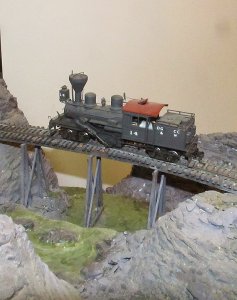
Next comes #15, a very special critter #15 was my first geared locomotive, a PFM Uninted 25 ton Hillcrest Shay purchased in the very late summer of 1968. My dad was a professional forrester, and a train nut. while in graduate school in the 30's he worked in the woods with Shays. he had lots of logging RR books, which he let me keep in my train library. I was facinated but geared power seamed out of my reach. # 15 sold new for the then outragious sum of $68.00, whe an AHM JW Bowker or Genoa could be had on sale for $12.00. a neighbor had a monsterous white oak tree removed, and gave dad the wood, cut into firewood lenghts. Dad offered to bay me to spit it to firewood by the chord. Champion (not sure if that that was before or after the Champion Paper/ US Plywood Merger, that produced Champion International) was putting in a new paper mill in Alaska that summer, and my dad was one of the guys in charge . He had picked the site out from the air, and he and the float pilot did the prelimianry survey work with a fishing line, and an old whiskey bottle found on site filled partly up with water from the river.
I split wood like a madman that summer; Dad was gone so much on business trips, and I didn't want to bother him when he got home; when he finally got around to paying me for the split wood, I had $50.00, an unheard of sum, I washed cars, mowed lawns , and did whatever to get that last $18.00. I bought it new from Mitchel's in Getysburg PA. from an add in MR; and boom I had a Shay. a that point The DG, CC, and W RR was being run as a partner ship between Steve Berghausen, Tim Shoemaker, Pete Sanders and Myself; We were working in a big room in Steve's basement. Steve ran some mining intersts in the mountians; Tim ran the logging operations, Pete oversaw our interchange with the D & RG w (my RR was in colorado at that time, and did not migate to TN until 1972, a full two years before I went to Tn to attend the University of the South in Sewannee Tn. I have been a Tn resident ever since.
#15 has been used harder than probably any other locomotive on my rosater. It's origianl motor burnt up, and was replaced by a gear reduction motor. The original mechanism/motor was smooth and good, but fast. the prototype had a top speed of 12mph. my Dad said that the usual working speed of a shay was slow enough that you could walk along the train and keep up. As I would run my trains, dad woul be behind me saying "slow down, that engine can't go that fast. the gear reduction motor solved that problem with this locomotive, it is as slow as molassas at chirstmas time. for may long years # 15 was a primary road lofggin locomotiv more recently # 15 has been the mill switcher in Crooked Creek, a busy place. A coulple years ago I moved #8 an MDC Shay into the mill switcher role, as that job gets a lot of action. at that time replacement parts were available for MDC Shays; but that is no longer true. all locomotive assignments are likely to change dur to my railroad's redesign/rebuild.
besides the gear reduction motor, #15 has been equiped with all wheel pick up, a necessity on thes tiny critters. cosmeticly it's rushton stack has been replaced with a cabbage stack. I have retained the original stack, and am tempted to reinstall it. I have an HOn3 version of the same locomotive, bit it is bone stock, and does not have the heavy wethering. If you can believe it , I have actually toned down the weathering on # 15!
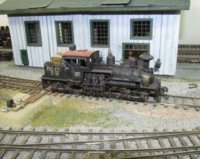
#16 is unavailable for a photo, as she is in the shops. ther is a thread in that in the logging section. I am attempting to remoter her, and get a Tsunami installed. the current motor/stunami combinations pulls to may amps, and kicks the circut breaker on the clubs DCC system after a few feet of travel.
#16 is visually narly Inentical to # 17, both of them being Riverossi 3 truck Heislers . # 17 has been remotored with a gear reduction motor form the motor man at Microlocomotion.com. I put a DCC decoder in #17 in hopes of using it at the club. but the gear reduction motor, which is perfect speed wise on DC, is painfully slow on DCC. I am Hunting for other motors to try on #16. we could really use a sound DCC 3 truck Heiler at the club, and the Tsunamis are dual mode, so they will work on DC (all though a little weirdly). If I give up, and remove the Tsunammi for use in another locomotive, I will try to put the same gear reduction motor in # 16 as resides in # 17, as it is a real hoss slow and as strong as a mule on steroids.
# 17 is shown her at the Harlow engine facilities. the photo is washed out, as the Harlow engine facilities are in the skylight opening of an eatern facing wall, and the photo was taken in the am. the engine facilities are not hooked up to the RR yet , I need to install some ties, and some beams over the ashpit in the foreground.
Next we will review # 18 and # 19; Yee who are weary of this be ye patcent. ther is no # 20, and the roster stops at #22. Of course after that I my go into the narow gauge. You are safe from my roster at the club, they are all modern **** and not suitable for this thread.
Nelson
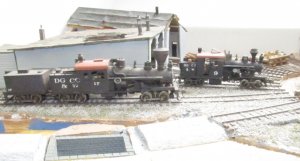
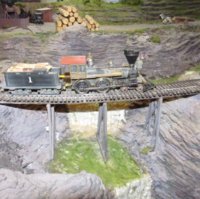
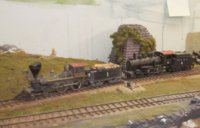 I really like the baggage car. I have recently aquired 3 Mantua 1880 combines.. I was sorely tempted to cut two of them up, and make a baggage car and a coach, but I had purchased them to use as cabeese, so I painted them red with black roofs and trucks, and put them into service as cabeese. . I am close to capaciry on passenger cars, could use a few more once I get my RR rebuild done, but bu that time I should have more time and $$ on hand, and may opt to build the rest od the fleet from Labelle Kits, hard to beat those.
I really like the baggage car. I have recently aquired 3 Mantua 1880 combines.. I was sorely tempted to cut two of them up, and make a baggage car and a coach, but I had purchased them to use as cabeese, so I painted them red with black roofs and trucks, and put them into service as cabeese. . I am close to capaciry on passenger cars, could use a few more once I get my RR rebuild done, but bu that time I should have more time and $$ on hand, and may opt to build the rest od the fleet from Labelle Kits, hard to beat those.

